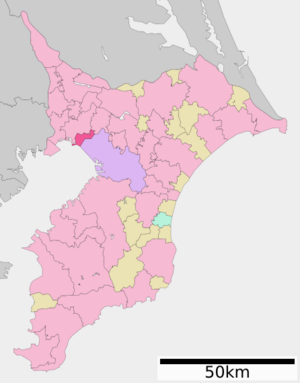Narashino facts for kids
Quick facts for kids
Narashino
習志野市
|
|||||||||
|---|---|---|---|---|---|---|---|---|---|

|
|||||||||
|
|||||||||

Location of Narashino in Chiba Prefecture
|
|||||||||
| Country | Japan | ||||||||
| Region | Kantō | ||||||||
| Prefecture | Chiba | ||||||||
| Area | |||||||||
| • Total | 20.97 km2 (8.10 sq mi) | ||||||||
| Population
(November 30, 2020)
|
|||||||||
| • Total | 175,292 | ||||||||
| • Density | 8,359.2/km2 (21,650/sq mi) | ||||||||
| Time zone | UTC+9 (Japan Standard Time) | ||||||||
| - Tree | Acacia | ||||||||
| - Flower | Hydrangea | ||||||||
| Phone number | 047-451-1151 | ||||||||
| Address | 2-1-1 Saginuma, Narashino-shi, Chiba-ken 275-8601 | ||||||||
Narashino (習志野市, Narashino-shi) is a city in Chiba Prefecture, Japan. It is located on the eastern side of Tokyo Bay.
As of November 2020, about 175,292 people lived in Narashino. The city covers an area of 20.97 square kilometers (about 8 square miles). This means it has a high population density, with around 8400 people per square kilometer.
Contents
Narashino's Location and Landscape
Narashino is in the northwestern part of Chiba Prefecture. It borders Tokyo Bay to the southwest. The city of Chiba, which is the capital of the prefecture, is to its east. Narashino is about 20 to 30 kilometers (12 to 19 miles) away from central Tokyo.
The city is built on the Shimōsa Plateau. It also includes land that was created by filling in parts of Tokyo Bay. Because of this, the land can be quite different in height from the inland areas to the coast.
Neighboring Cities
Narashino shares its borders with these cities in Chiba Prefecture:
- Chiba
- Funabashi
- Yachiyo
Narashino's Climate
Narashino has a humid subtropical climate. This means it has warm summers and cool winters. There is usually little to no snowfall.
The average yearly temperature in Narashino is about 15.4 degrees Celsius (59.7 degrees Fahrenheit). The city gets about 1410 millimeters (55.5 inches) of rain each year. September is usually the wettest month. Temperatures are highest in August, around 26.9 degrees Celsius (80.4 degrees Fahrenheit). They are lowest in January, around 4.9 degrees Celsius (40.8 degrees Fahrenheit).
How Narashino's Population Grew
The number of people living in Narashino grew very quickly between 1950 and 1990. Since then, the population has continued to grow, but at a slower rate.
| Historical population | ||
|---|---|---|
| Year | Pop. | ±% |
| 1950 | 28,667 | — |
| 1960 | 42,167 | +47.1% |
| 1970 | 99,995 | +137.1% |
| 1980 | 125,155 | +25.2% |
| 1990 | 151,471 | +21.0% |
| 2000 | 154,036 | +1.7% |
| 2010 | 164,530 | +6.8% |
| 2020 | 176,167 | +7.1% |
Narashino's History
People have lived in the area around Narashino for a very long time. Archaeologists have found ancient shell mounds and other items from the Jōmon period. They have also found burial mounds from the Kofun period. For most of its history, however, the area was mostly wetlands and swamps along Tokyo Bay.
After the Meiji Restoration in 1868, a village called Tsudanuma was formed in 1889. It was created by combining five small villages with about 4500 people. The area started to grow when the railway arrived. Tsudanuma became a town in 1903, with a population of 6000.
The Narashino area of Tsudanuma was used for military training. The Meiji Emperor visited it in the early Meiji period (1868–1912). A camp for prisoners of war was built here in 1904. It held POWs from the Russo-Japanese War and World War I. The Imperial Japanese Army also had a main training school here for cavalry and later for tank warfare.
On August 1, 1954, Tsudanuma merged with part of the nearby city of Chiba. This merger created the new city of Narashino.
Narashino's Economy
Narashino is an important business area in the region. Many people who live in Narashino travel to work in nearby Chiba and Tokyo. In 2010, about 32.7% of residents commuted to Tokyo.
The coastal area of Narashino, which is mostly on reclaimed land, is part of the Keiyō Industrial Zone. This area has many large factories, especially those that work with chemicals.
Getting Around Narashino
Narashino has a good public transportation system, mainly using trains.
Railways
Narashino is served by several train lines:
- JR East – Sōbu Main Line
- Tsudanuma
- JR East – Keiyō Line
- Shin-Narashino
- Keisei Electric Railway – Main Line
- Yatsu - Keisei Tsudanuma - Keisei Ōkubo - Mimomi
- Keisei Electric Railway – Chiba Line
- Keisei Tsudanuma
- Shin-Keisei Electric Railway – Shin-Keisei Line
- Keisei Tsudanuma - Shin-Tsudanuma
Education in Narashino
Narashino has many schools for its young residents.
- Chiba Institute of Technology is a university located in the city.
- The city government runs 16 public elementary schools and eight public middle schools.
- The Chiba Prefectural Board of Education operates four public high schools in Narashino.
Fun Places to Visit
Narashino has several interesting places for people to visit and enjoy.
- Akitsu Baseball Stadium
- Frontier Soccer Field (also known as Akitsu Soccer Stadium)
- Chiba International General Swimming Center
- Ōnomatsu stable (a place where sumo wrestlers train)
Special Natural and Garden Spots
- Yatsu-higata (谷津干潟): This is a protected wetlands area for migratory birds. It is recognized internationally as a Ramsar Site. During spring and summer, you can see more jellyfish and small crabs in the wetlands.
- Yatsu Rose Garden (谷津バラ園): This beautiful rose garden shows off over 6,000 different rose blossoms. The best times to visit are in May and October. The garden was once part of an amusement park called Yatsu Yūen. When the park closed in 1982, the city bought the garden and has taken care of it ever since.
Sister City
Narashino has a special friendship with a city in the United States:
Famous People from Narashino
Many talented people come from Narashino, including:
- Daichi Suzuki, an Olympic gold medalist in swimming. He won the 100m backstroke at the 1988 Summer Olympics.
- Daiki Arioka, a member of the Japanese idol group Hey! Say! JUMP.
- Hideaki Kitajima, a professional soccer player.
- Kazuya Fukuura, a professional baseball player.
- Kota Hattori, a professional soccer player.
- Makoto Sunakawa, a professional soccer player.
- Masaaki Takada, a professional soccer player.
- Hōō Umagorō, a sumo wrestler.
See also
 In Spanish: Narashino (Chiba) para niños
In Spanish: Narashino (Chiba) para niños





